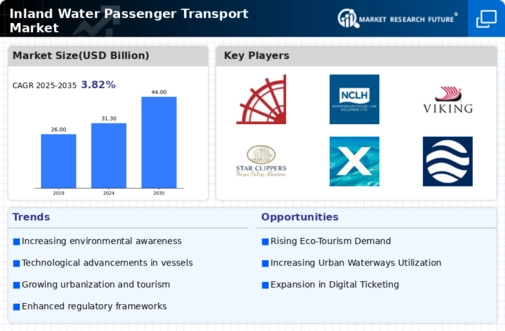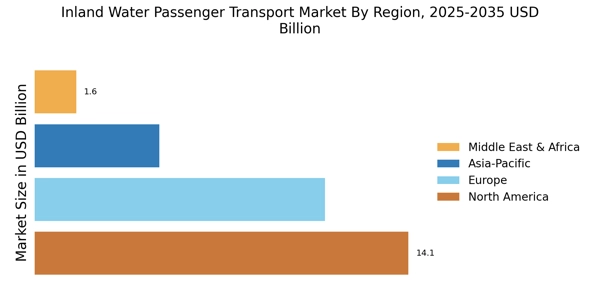Technological Integration
Technological integration plays a pivotal role in shaping the Inland Water Passenger Transport Market. The adoption of advanced technologies, such as GPS tracking, automated ticketing systems, and real-time passenger information, enhances operational efficiency and customer experience. These innovations facilitate better route planning and scheduling, which can lead to increased ridership. Moreover, the integration of mobile applications allows passengers to book tickets and access information seamlessly, thereby improving overall satisfaction. As technology continues to evolve, it is likely that the industry will see further enhancements, including the potential for autonomous vessels. This could revolutionize the way inland water transport operates, making it more efficient and appealing to a broader audience.
Experiential Travel Demand
The demand for experiential travel is significantly impacting the Inland Water Passenger Transport Market. Travelers are increasingly seeking unique and immersive experiences, which inland water transport can provide through scenic routes and cultural interactions. This trend is particularly evident in regions with rich historical and natural landscapes, where water transport offers a distinct perspective. According to recent data, the market is expected to expand as more tourists opt for journeys that combine leisure with exploration. Operators are responding by curating specialized tours that highlight local attractions and promote cultural heritage, thereby enhancing the overall travel experience. This focus on experiential travel not only attracts a diverse clientele but also contributes to the economic vitality of regions reliant on tourism.
Sustainability Initiatives
The Inland Water Passenger Transport Market is increasingly influenced by sustainability initiatives aimed at reducing environmental impact. Governments and organizations are promoting eco-friendly practices, such as the use of electric and hybrid vessels, which are gaining traction. This shift is driven by a growing awareness of climate change and the need for cleaner transportation options. In many regions, regulations are being implemented to limit emissions from traditional vessels, thereby encouraging operators to adopt greener technologies. The market is projected to grow as consumers increasingly prefer sustainable travel options, with a notable rise in demand for services that prioritize environmental stewardship. This trend not only enhances the appeal of inland water transport but also aligns with broader global efforts to achieve sustainability goals.
Government Support and Investment
Government support and investment are crucial drivers of the Inland Water Passenger Transport Market. Many governments recognize the potential of inland water transport as a sustainable and efficient mode of travel. Consequently, they are allocating funds to improve infrastructure, such as ports and terminals, and to promote the development of new services. This financial backing not only enhances the operational capabilities of existing operators but also encourages new entrants into the market. Additionally, public-private partnerships are becoming more common, facilitating innovation and expansion within the industry. As governments continue to prioritize transportation solutions that align with environmental goals, the inland water passenger transport sector is likely to experience robust growth, supported by favorable policies and investment initiatives.
Urbanization and Population Growth
Urbanization and population growth are driving factors in the Inland Water Passenger Transport Market. As urban areas expand, the demand for efficient and alternative modes of transportation increases. Inland waterways present a viable solution to alleviate congestion on roads and provide a reliable means of transit. In many metropolitan areas, investments are being made to develop and enhance water transport infrastructure, including terminals and docking facilities. This trend is expected to continue, with projections indicating a rise in passenger numbers as more people seek convenient travel options. Furthermore, the integration of inland water transport into urban transit systems could lead to a more sustainable urban mobility framework, benefiting both residents and visitors.


















Leave a Comment